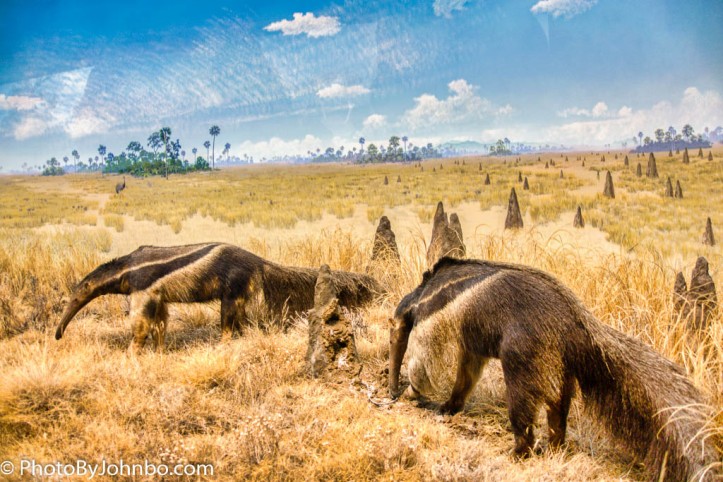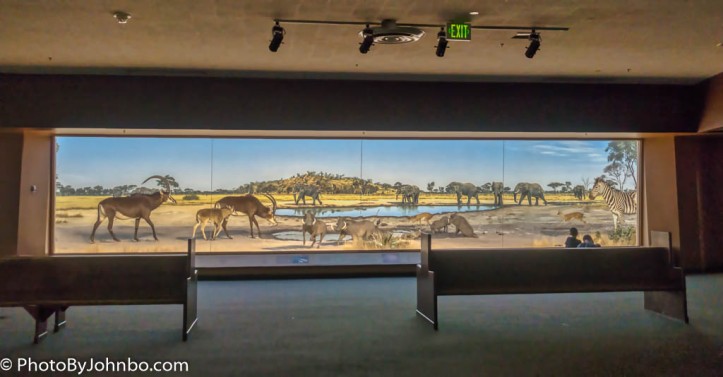Denver, Colorado.
Last week’s Travel Tuesday found us at the Denver Museum of Nature and Science. The large collection of animal species are documented in 89 dioramas. Not being much of a world traveler, I have chosen to focus mostly upon the many places to visit in the United States. Since becoming a blogger, however, I’ve met many online friends who have shared their particular view of the world. One such blogging site takes me to Africa every week. de Wets Wild is an award winning travel blog focusing on the Mother Continent’s abundant wildlife. I will probably never go on an African photo safari, but I have been living that dream through the de Wets blog. You can read about their adventures here.
And that brings me to the topic at hand, a virtual safari to view some of the iconic animals and landscapes of the cradle of civilization. The displays like the example in the opening photo present a glimpse into the vast plains and great deserts. Though the photos I captured appear almost as if the animals are paintings, they consist of taxidermy, simulated plants and foreground elements, and beautifully painted backgrounds. Where else could I stand and study the exposure, composition, and other technical aspects of an image as a predator dashes after its prey. The displays are not only works of art, but are scientifically and technically as accurate as they can be made given the small physical constraints.
Most of the images captured in this post focus on smaller components of a larger diorama. That was done for two reasons, not the least of which is positioning to avoid the inevitable reflections on the glass protective fronts of the displays. The other reason is that many of the dioramas have too much detail for their large size making it hard to view detail on a typical web page.
As I prepared to put this post together, I did my usual “research”, an online search for information about the dioramas at the museum. In the search results, I discovered an interesting article entitled “Museum Dioramas Are as Endangered as the Animals They Contain” published in August, 2015 on the Newsweek Magazine website. As you might imagine, the easy availability of travel, video and photography gear, virtual reality displays and other modern visual technologies, prompted one curator to write that dioramas “are often viewed by today’s visitors as a dead zoo located in a dark tunnel.” Even so, the article goes on to say that those who feel that the dioramas are going away may be wrong, citing some examples of a resurgence of the technology. You can read the entire article here.
I must admit to feeling there might be something wrong with the preservation of these magnificent animals in a display when I can find any number of online videos where I might see live animals in motion living their daily lives. Some of what was said in that Newsweek article echoed my feelings as I walked through the displays. Yet, they are so well done that they can be studied with the understanding that they are technically correct in their portrayal and that the information on nearby plaques reflect an educational experience that is first rate. You can review more of the sights I captured at the Denver Museum here.
Creating these images in post processing was a fun process for me. I needed to try to eliminate all reflective cues that these images were not from the “real world”. I leave it to you to judge how well I did. I submit the entire gallery of images I prepared for you to view from my own virtual African photo safari. As always, you can click on an image to enlarge it and to scroll through the gallery (at least in most browsers, anyway.)
John Steiner













Love this one
Thank you, and thanks for stopping by,
I’m not much of a world traveler either (my last big trip was Germany, 1993!) and I LOVE history museums. Very nice array, John.
Thanks. It was fun putting these together.
Looks like the next best thing to actually going to Africa on safari. Yes, De Wets Wild has an amazing blog. I love it too. 😃
They have done a wonderful job on creating those natural works of art.
Amazing images of the animals! So well done!
Thank you for the post, John.
Thank you for stopping by and commenting!
That looks like a fun way to kill a few hours!
It is indeed!
Firstly a huge thank you for your kind words about our blog, John. We honestly appreciate it immensely.
I find the displays you’ve shown here really lifelike – especially the cheetah chasing after the impalas is amazing! – and if accompanied by informative interpretation so that visitors to the museum has a wider view of the ecosystems represented, then the work that went into creating these masterpieces were really worth it!
You are welcome. I always look forward to your blog posts. Each of the dioramas are accompanied by informational plaques identifying and detailing the components in each scene.
Hi John – was here in March but also came back from your Link this week (December 2019) –
The museum is awesome and I hope the dioramas do not fall
Out of fashion too much. I almost thought you were going to see that people were protesting for some animal activist reason…
Hmmmm
I imagine there might be some pushback from animal activists as well, but I didn’t get that sense from the articles I read on the subject. Thanks for stopping again and taking the time to comment.
😊